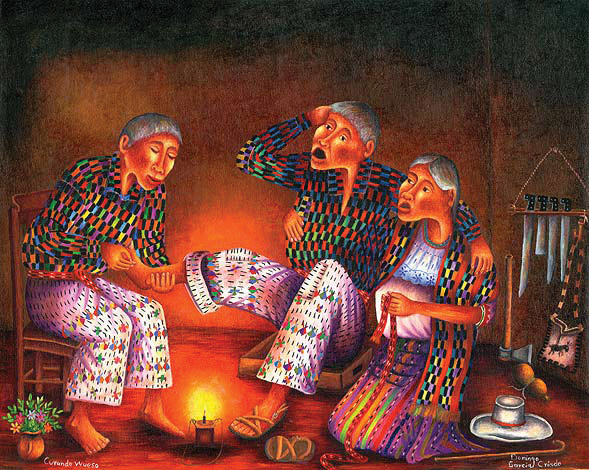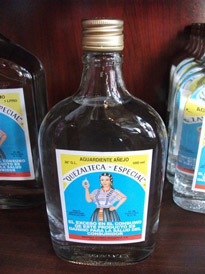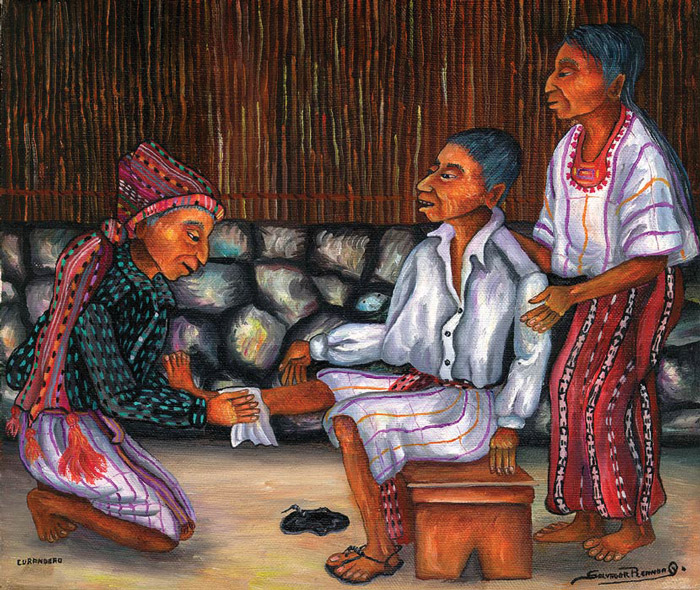María the Bonesetter, Lake Atitlán
A visit to a traditional Maya Huesero.

Curandero (Healer) 1990 Salvador Reanda Quiejú (artemaya.com – collection)
One evening I was walking down a familiar shortcut in San Pedro La Laguna. I hadn’t bothered to turn on my cellphone light. The tip of my sandal caught on a rock and I fell sideways, landing on a chunk of concrete, my hands clenched beneath my right ribs. Breathing was painful, all other movement excruciating. I gritted my teeth, pushed myself up and continued haltingly to a nearby restaurant.
I had only recently healed from falling flat on my back across the hull of the lancha after the boat moved when I was climbing up to disembark at Panajachel. It had taken three months to be pain-free.
Western medicine says there is little to do about rib problems beyond taking pain medicine until you feel better. I didn’t want more pain medicine nor could I afford three more months of limited activity.
“You need a huesero, a bonesetter,” my friends at the restaurant said as I continued to moan. “María lives close, she is very good. We will call her now for you.”
María arrived within minutes. She began to work on me immediately in the restaurant but I was unable to endure it quietly so we made our way to my house. It was impossible to imagine that such a pleasant young woman was capable of inflicting the excruciating pain that followed.
Lake Atitlán is known for talented huesersos, traditional Maya bonesetters. I had heard both successful and unsuccessful accounts of their services. What came to mind was a mural I’d seen in San Juan where a screaming patient was being held down, an empty bottle of Quetzalteca, a potent local alcohol, near him as the huesero sets his leg.
María rubbed unceasingly at the point of the greatest pain, her face tranquil, while I continued screaming. I asked her where my Quetzalteca was, and she just smiled. At the end of a half an hour, and three breaks, I was utterly exhausted and just wanted to take a pain pill and go to bed.
María left saying she would be back the next day. I felt a little better when she came by so I said, “not today,” hoping the following day would be even better. It wasn’t. When María returned, confident and tranquil, I said, “OK, let’s do it again.”
It was no less painful and I was no less expressive. And then, after perhaps 15 minutes, I heard my rib go back into place, followed by a tremendous physical relief. I was slightly sore for the next week, but the change in my mobility had been immediate.
I went to visit María Rodríguez González to thank her again and to find out more about her work as a huesero. I was shocked to discover she was only 23, as her presence was that of a mature practitioner.
María told me that she was 11 when she performed her first bone setting. Her younger sister had a club foot. María began rubbing the foot with her hands and her special stone to reset the bones in the foot so that her sister now walks normally. Her mother added that María had fixed a problem she had with her hip so that she was now pain-free.
“Many people come to see me for help,” María said, “or I go to them. Once there was a foreigner who had dislocated her arm at the elbow so that it hung like a doll’s. I rotated her arm until it was in place, then secured it with cloth to rest the muscles.”
“But how did you learn to do this?” I asked.
“I did not learn it. I just knew how.” María told me.
“Did you have a relative who is a huesero? Or study anatomy charts or books?” I asked, having had to pass a detailed exam in anatomy and physiology before practicing massage.
“No,” María said. “I just knew what to do. It’s my don, my work to serve the community in this way. When I was born, I had a caul, a veil of skin over my face. This is a special sign among the Maya. We are either midwives, hueseros, herbal healers or a shaman. The midwife told my mother I was a huesero and to look for signs of this.
“As a child, I liked rocks very much and I had collected 10 of them, with different colors, which were special to me. One day my family went to the finca, outside of town. I had taken all 10 of my stones with me.
I threw them all onto the land, far from my house. When I came home one of the rocks which I had thrown to the finca was there was among my things. It had returned. I use this stone in my work. It helps me find where the bone is broken or needs attention.
Also, I massage this place with the stone as well as my hand. Sometimes the bone can be set in one session or it may require repeated sessions over several weeks.”
Her don requires that María not ask a price for her services, though donations are welcome. Bring your own Quetzalteca.
REVUE article by Louise Wisechild


Thanks for your interesting article. I live in Belize where gueseros are also a very important part of the first responder medical community in Maya villages. My mentor, Don Elijio Panti, was also a good guesero. What you say about the extreme pain is quite true. Excruciating! They work directly on the sorest spots and do not let up no matter how much you howl, but it always works.
Rosita Arvigo
San Ignacio, Cayo
Belize